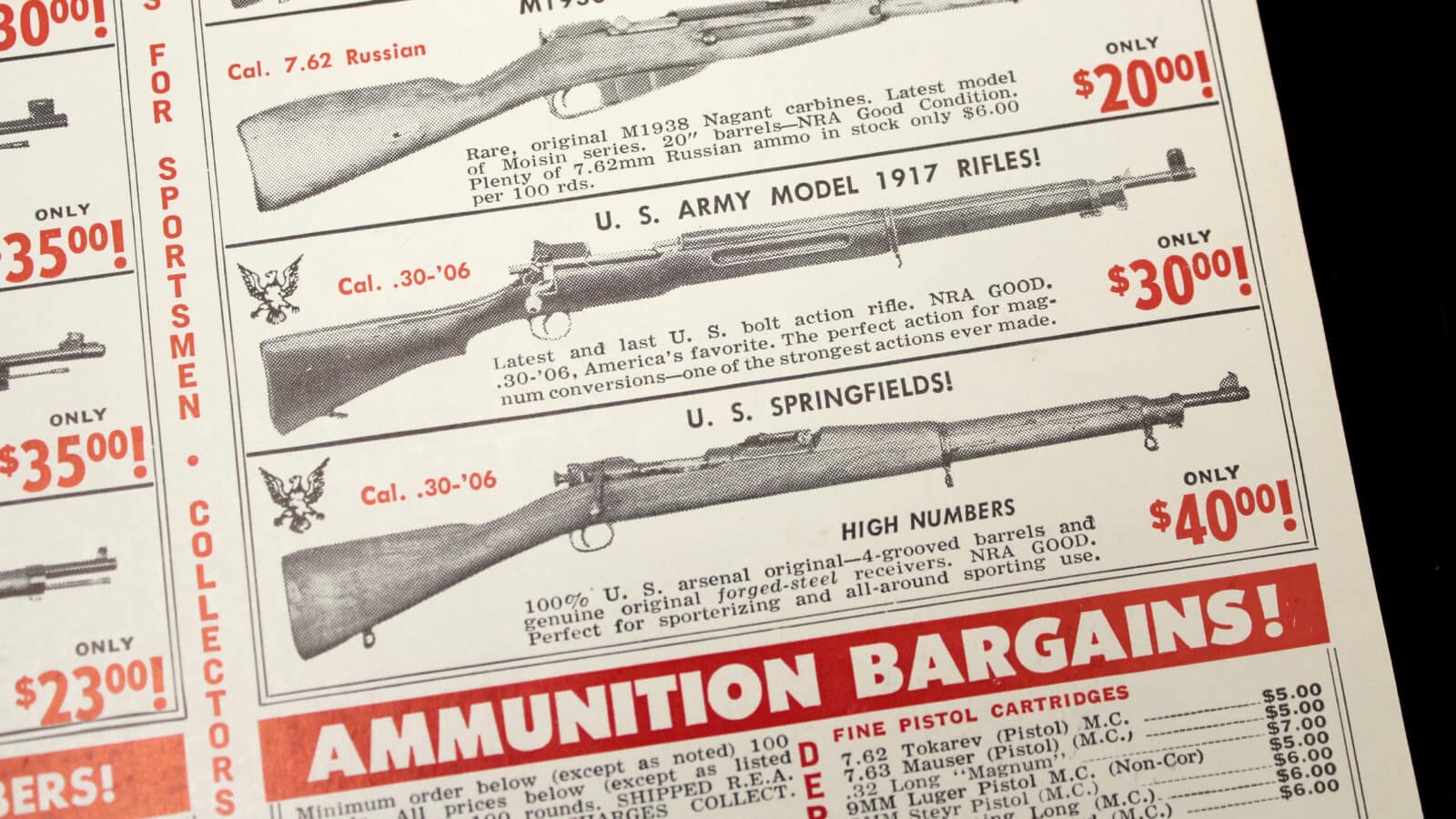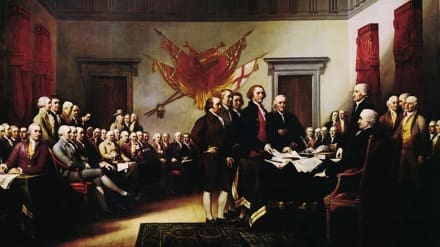In today’s article, the author explores the idea of investing in guns. This is purely an informational article that considers if guns are a good investment. It is not investment advice. The author’s views are his own and not necessarily those of The Armory Life. Always consult a qualified financial advisor when examining investment opportunities.
It’s likely you’ve seen it before. Someone will post a picture of a dusty ad back from the 1950s or 1960s with a variety of desirable firearms being sold at eye-popping prices. I happened across one of them recently: how would you like to live in a time when you could buy a USGI M1911 for $60? How about a Kar 98k for $30, or a 1903 Springfield rifle for $40?
For a few of us, these ads invite a trip down memory lane. The rest of us are left yearning for a time machine. Supposing we had one, we’d certainly pad our own collections with a variety of some of the best and most enduring firearm designs throughout history. However, laying eyes upon these prices tends to trigger another common “what if” scenario: Imagine how much money a person could have made if they’d stocked up and re-sold at today’s prices!
Of course, there’s a more realistic train of thought to be pursued: we can’t go back in time, but is it a good idea to purchase guns today with the intent of selling them later, specifically as investments or as part of a rainy day fund? Let’s explore what’s tricky — and potentially troublesome — about that concept.
Inflation and Opportunity Costs of Gun Investing
I’ll be honest: most of the time when I see internet threads were people are recalling the good ol’ days of being able to buy SKS and Mosin Nagant rifles for the cost of a large pizza, I’m practically shouting “Inflation!” at my monitor.

Fundamentally, the United States Dollar is worth less over time. Any person with the literacy skills to read this article has experienced inflation up close and personal in our post-pandemic economy. I don’t need to tell you that the money of 2024 has less purchasing power than it ever did in our nation’s history. A trip to the grocery store can be as instructive as a university macroeconomics course!
Crunching the numbers, that $40 1903 Springfield being sold in 1966 has an equivalent 2024 price of $390.40. Given that “shooter grade” 1903s are going for about $1,200 today, give or take a few hundred bucks, you would have quadrupled the real value of your money if you’d bought the rifle then and resold it some 58 years later. That sounds pretty good to most of us!
But let’s suppose you took that same $40 and put it in the S&P 500 index fund, almost universally regarded as a “safe” investment, and one which has historically delivered about a 9% year-over-year return. That same $40 would be worth $5,926 today.

For yuks, I also crunched a few numbers when it comes to investing in yourself. Cross-comparing info from the Education Data Initiative and the US Department of Commerce, the average cost of one year’s college tuition in 1966 was $302, and college graduates of 1966 tended to earn about $200,000 more than their high-school educated counterparts over the course of a lifetime. In plainer terms: if you went back to 1966 and spent the equivalent of a Springfield 1903 on your intellectual advancement, it would translate to about $6,700 in lifetime earnings.
My point is that in terms of actually measuring what most of us would consider legitimate, unquestionable investments, the performance of firearms falls a little short.
Gun Investments — Hindsight and Logistics
You’ll notice that so far, I didn’t mention investing in Google or Microsoft. If you put $40 into either IPO, and accounting for stock splits, those investments today would be worth about $2,800 and $235,000, respectively. According to this gunwriter’s back-of-envelope calculations, anyway. Naturally, hindsight is 20/20, and logically we know that not every stock is going to deliver eye-popping returns.

Now let’s apply that same logic to firearms. Congratulations to those who had the good horse sense to grab a semi-auto French FAMAS rifle imported in the late ’80s, or anyone who inherited a .44 Dragoon revolver from a Great Grandpappy who served in the U.S. Cavalry. Those firearms move for gonzo bucks these days.
However, there are far more vintage and antique firearms that are not worth very much to anyone. Head down to your nearest large gun store right now: I guarantee you will be able to find at least one .32 “top break” style revolver — of late 19th century vintage — for less than a couple of C-notes. Yes, they’re old, but they don’t resonate in the American psyche nor have much to recommend them as functional shooters. Often, new generations are absolutely gobsmacked to find them in an attic or long-forgotten toolbox, thinking they’re worth their weight in gold. The excitement fades when they have them appraised.
Beyond that, consider the logistics of storage and selling. Condition matters! If you’re going to hold onto a gun long-term for later re-sale, are you monitoring for humidity and keeping it free of scratches, dings, and dents? Additionally, who do you imagine is going to buy at your asking price? My local gun store had a very desirable handgun in the case marked at $8,000 — a fair price, admittedly. Problem was, just about no-walk ins were prepared to drop that kind of coin. As a result, it went to a local auction house for sale — who of course took a cut of the hammer price for their trouble.
I would also add that the federal government takes a dim view of regular people “engaged in the business of firearms” without an FFL. Naturally, one would be well-advised to go straight to the source on this, and the ATF has a good primer at www.atf.gov/file/100871/download. I can offer a brief and partial summary here, though it comes with the caveat that I am not a lawyer and am not offering legal advice.

According to the ATF’s own language, “occasional sales” are fine; a self-proclaimed investor repeatedly acquiring and selling guns for the explicit purpose of earning a profit is not. Intent matters with respect to determining whether a firearm is part of what the federal government considers a “personal collection.” Additionally, you are certainly allowed to make a profit from what you sell out of your personal collection, but a firearm cannot and should not be purchased only as a potential moneymaker.
As such, the idea of using guns as the foundation of a legitimate wealth-building strategy becomes logistically very difficult, and it would require one to obtain a Federal Firearms License if they nevertheless wished to make the effort.
[Ed. note: Gun laws change and the BATFE is known to change its interpretation of existing laws when it comes to deciding what to enforce and how. Consult an attorney prior to engaging in the purchase and resale of any firearm for profit.]
The Other Way To Think About Investing in Guns
What I typically tell people is this: guns may not be good investments, but the firearms in your personal collection can be excellent stores of value. Unlike the laptop on which I am typing this article, or the car parked in your garage, it is doubtful your firearms will be worthless, broken junk in 15 years. Much to the contrary, they will very likely be worth a good chunk of money several decades later if they remain in good, shootable condition.

As such, guns that are both desirable and financially attainable are often very “liquid” as far as durable goods go. Some may not think of a 9mm Springfield XD the same way they might a bar of silver or Rolex watch, but I guarantee you that someone will always be interested in a “duty” type pistol in a common caliber. Certainly, my local shops found themselves utterly cleaned out of literally any 9mm pistol at the height of the pandemic.
Additionally, solid, proven designs with more than a decade of performance history will always be “known quantities” with inherent worth to a large contingent of buyers. Since I was in college — a good two decades past, mind you — the Springfield TRP has been highly desirable and consistently sells at a high price on the secondary market.
I have also found that most of the firearms in my own collection have kept pace with the effects of inflation over time. Again, they haven’t “appreciated” in real terms that would ever get close to beating the stock market, but the worth of my own collection has grown faster than the portion of my money sitting in a savings account at a half-percent interest rate.

All that said, here’s the more fun way to look at things. Suppose you find yourself drooling over one of Springfield Armory’s vaunted “Professional” models. That $3,600 price tag is certainly not small potatoes. But, if you told yourself you were going to sell it at the end of three years, and putting inflation aside, I think it’s utterly reasonable to get at least 85% of that gun’s value back on the secondary market — a little more than $3,000.
This raises an interesting question: would you “lease” the gun of your dreams for a net cost of $600, especially knowing you could end the terms of that lease whenever you wanted to? I think a lot of people would answer “yes” to that question.
Additionally, we can talk about a lot of firearm purchases in the same way we talk about “starter homes.” That is, they might not be something you’ll still have in 30 years, but can be a real asset that helps you bridge the financial gap to the gun with the build quality and feature set you really want. The rough-but-honest example of a German K98k in your collection today can be used to partially fund a Model 2020 Waypoint tomorrow.
In short, firearms might not be investments in the conventional sense of the term, but nearly every quality firearm has monetary value. In the beginning, many of us looked to our rainy day funds as the primary means of adding to our collection. I would posit that a great number of experienced shooters and firearms connoisseurs will view each firearm collection as a rainy day fund in itself.
Editor’s Note: Please be sure to check out The Armory Life Forum, where you can comment about our daily articles, as well as just talk guns and gear. Click the “Go To Forum Thread” link below to jump in and discuss this article and much more!
Read the full article here







Leave a Reply